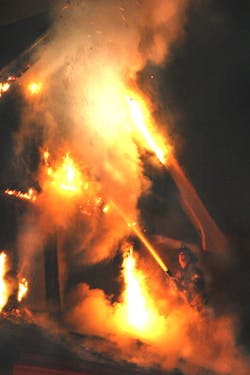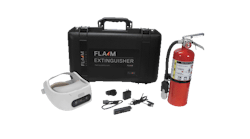Is There Anything Wrong With 1 1/2-inch Hose?
A few months ago, I received a request from a firefighter researching the possibility of his department converting from 1-1/2-inch to 1-3/4-inch attack lines. I field these requests a few times a year and usually find that an organization is about to commit an enormous amount of funds to replace perfectly serviceable hose in a not-fully-informed effort to increase flow rates on their initial interior attack lines.
My first question to this person was what was his desired target flow rate and what was he flowing on his handlines now? While his answers were relatively vague, it didn't take long to determine that the primary reason for the request was that all the neighboring departments were using 1-3/4-inch hose and he wanted his to do the same.
Many fire officials are laboring under the mistaken assumption that they have to increase hose size to increase flow rates. While it is true that increasing hose size will reduce friction loss and in theory, increase the water available at the nozzle, I always suggest that the problem of "not enough knockdown power," almost always lies with the nozzle, not the hose.
It is less expensive to replace nozzles or reset their flow rates than it is to re-equip the department with hundreds of feet of a new attack hose size. It makes perfect sense that a department wanting to increase flow rate should begin at the nozzle, then work backwards.
Where did 1 3/4-inch hose come from and why is it so popular? To find that answer it helps to know something about its origins. In the middle 1960's, the Rand Corporation was commissioned by the New York City Fire Department to find a way to flow 250-gpm inside a fire building without having to use 2-1/2-inch hose.
At the time, some engine companies in the south Bronx and Brooklyn were battling five to eight fires a day, literally beating the firefighters senseless as they fought fire after fire with heavy hoseliness. The goal was to flow 250 gpm with hose that was smaller and lighter than 2- 1/2-inch.
The Rand Corporation, a "think-tank" did calculations and searched for new technologies that could aid their effort. What they came up with was use of a long-chain polymer chemical called "rapid water," to reduce friction in flowing water, along with a complicated injection system and 1-3/4-inch hose equipped with an automatic fog nozzle or later, a 15/16-inch smooth bore.
Later on, the FDNY found that if they eliminated the rapid water additive (the injection system was complicated and plagued with maintenance problems) a combination of 1-3/4-inch hose and a 15/16-inch smooth bore nozzle, provided them with an average flow of around 170 to 180 gpm, resulting in streams that proved both maneuverable and having enough punch to knock down most any interior fire.
Hose manufacturers, wanting to open up new markets and sell more hose, began beating the 1-3/4-inch hose drum in the early 1970's. Many departments were convinced that by going to the new hose size and purchasing expensive nozzles, they could flow 200 to 300 gpm on their initial attack lines, mainly because they believed a hose or nozzle manufacturer's claims.
In theory, a 1-3/4-inch line can and will provide flow rates up to 250 gpm, but, there are two important points that must be remembered. First, engine pressures from 200 to 300 psi must be provided on each line to obtain high flows from this system, and second, since most combination nozzles have their flow rates calculated at 100-psi nozzle pressure, the lines will generate high reaction forces that prove to be so difficult to handle that they border on being unsafe.
It is human nature for the nozzle operator, having trouble handling excessive reaction force, will tend to reduce this force by throttling the shutoff until the flow is reduced to a manageable level. In some cases, the pump operator is instructed to reduce the engine pressure until the nozzle reaction feels safe enough to work with.
So, even if the desire is to flow more water on the fire in the first place, human nature and common sense calls for the reaction force to be reduced to a safer level, which will always cause a reduction in flow rate.
Since nozzle reaction is generated by a combination of the weight of the water flowing (gpm) and the pressure at which it exits the tip, if it is desired to maintain or increase the flow rate, the only way to reduce reaction force is to either reduce the flow rate or reduce the nozzle operating pressure.
Once this fact is realized, it is a simple matter to evaluate two nozzle types--smooth-bore and low-pressure combination--in order to provide more flow rate at safer reaction forces. If it is determined that it may be desirable to stay with the same attack line hose sizes that are presently in service, testing can be concentrated on maximizing flows by selecting suitable, low-reaction-force nozzles.
By simply changing nozzle styles, pump pressures can be materially reduced over those needed to supply the same or increased flows than when using nozzles that operate at 100 psi. On the other hand, if the same engine pressures are used, low pressure nozzles will increase the flow rate.
When using 1-1/2-inch hose, friction loss is the only factor that limits the flow rate and length of hoselines. But, most standard friction loss charts list figures for friction losses in 1-1/2-inch hoseliness that may result in erroneous results. I think that the reason for the high friction loss numbers in these charts is that most of the research and study of friction loss occurring in the past 20 years has been concentrated on 1-3/4-inch and larger lines.
Since the 1-1/2-inch size has largely been ignored and considered old fashioned, industry developments such as thinner, high strength hose linings and thinner, high technology woven jackets (advances that have revolutionized and reduced the friction loss figures for other hose sizes), have not been properly and timely calculated for 1-1/2-inch hose, even though these improvements have been incorporated in the construction of this hose size as well. For example, for almost 10 years, the internal diameter of 1-1/2-inch size hose has actually been 1-5/8-inch or larger, attributable in part to thinner hose wall materials.
In actual practice, 1-1/2-inch hose coupled with nozzles that operate at pressures between 50 and 75 psi, flows up to 160 gpm can be obtained relatively easily.
For example, after extensive testing, the Detroit Fire Department decided to remain with 1-1/2-inch hose but upgraded their nozzles to low pressure versions flowing 125 gpm at 75 psi. This provides them with a mobile line that can be maneuvered and moved quickly by a single firefighter.
Another question I ask when evaluating attack hoseliness is if the department continually has problems with the fire not going out. Sounds like a simple question, but if there is no problem with the available flow rate doing its job, and if the available firefighters can easily handle the line, is there any reason to change?
Because of the limited flow of all common diameter attack hand lines, 1-1/2-inch, 1-3/4-inch or 2-inch, it must be remembered, that these lines are not all-purpose, all-fire, all-use devices. If the size of the fire dictates, use a larger line or bring in the heavy artillery.
It is certainly more cost-effective to re-equip present 1-1/2-inch hoseliness with higher flow, low pressure nozzles than to purchase new hose. To make the new hose work properly, it's a good bet that new nozzles will have to be purchased eventually, so it makes sense to evaluate them first, and maybe you'll find that new hose will not have to be purchased after all-that is unless you just want to impress the neighbors.






